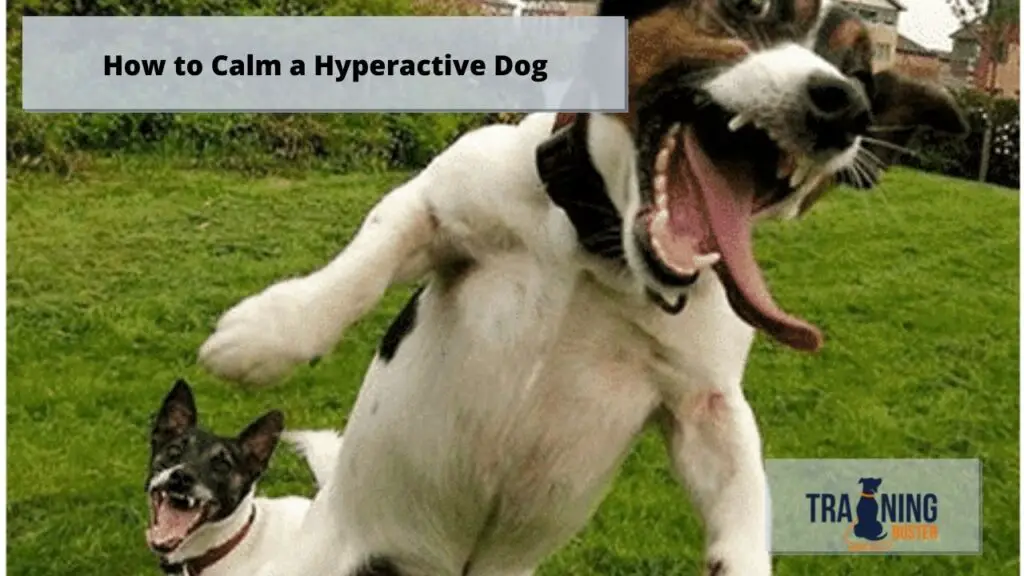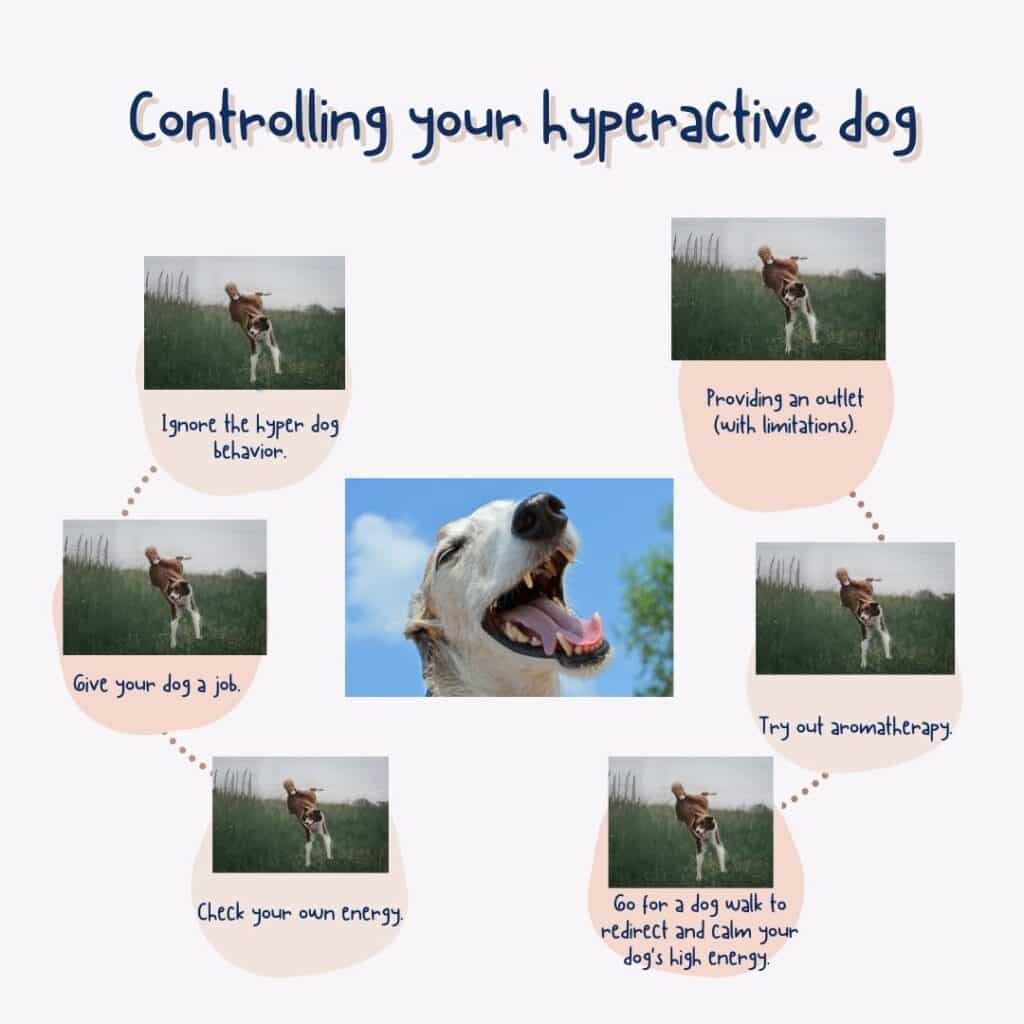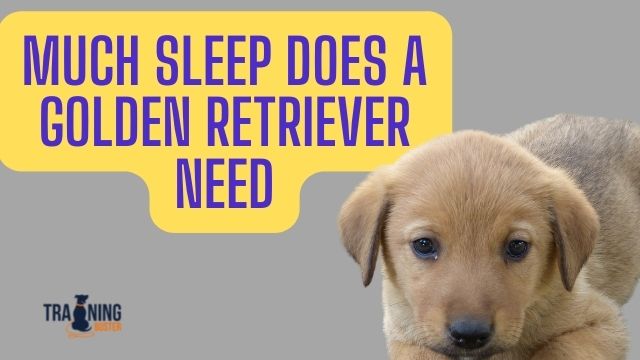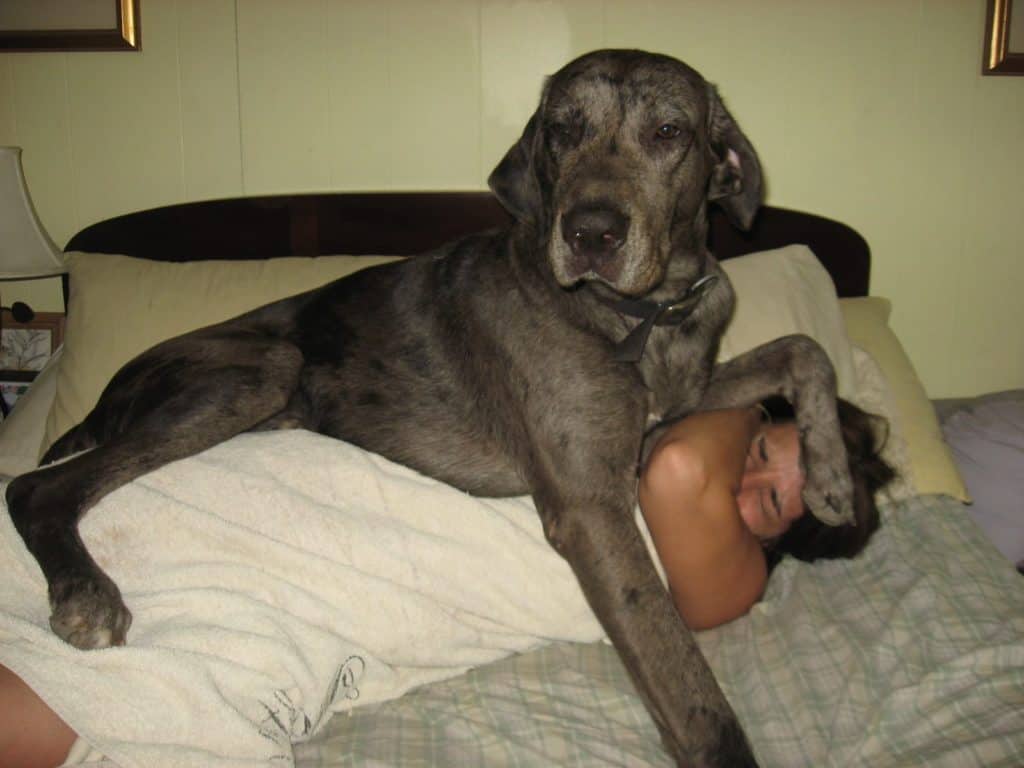
Learn how to calm a hyperactive dog?… The short answer is:
Work body games and plenty of exercises. Work in the brain Mental exercise is a phenomenal way to wear out the dog. And reward for calm behavior.
A dog that’s spinning in circles, jumping up and down, or barking and yipping is not a happy dog. These are all signs of over-excitement. The dog has excess energy, and the only way her brain knows how to deal with it is to work it off physically.
Unfortunately, people often interpret these signs as happiness. Many also tend to think that it’s cute when a dog acts like this, and wind up unknowingly encouraging the behavior.
Curb your dog’s excitement and you’ll be preventing misbehaviors in the future, including aggression. An excited dog is not happy. A calm dog is. If your dog seems hyper, or overly excited, the problem likely stems from boredom and a lack of stimulation.
So in order to address the problem, you have to assess the way you are interacting with your dog and the kind of activity your dog gets on a daily basis.
What can you do to calm a Hyperactive Dog?
Work on the Body
First, consider your dog’s exercise requirements versus what he’s actually getting on a daily basis.
If you have a high-drive dog from the sporting or herding groups (picture a Border Collie), or even a mixed breed dog who seems to exhibit those same “can’t slow down” tendencies, your dog is going to need a new workout plan and a coach to go with it—that’s you!
There is no universal canine exercise standard, but it’s a safe assumption that if your dog is in constant motion and unable to settle down even at the end of the day, he probably needs more exercise than he’s getting.
You can vent some of that excess energy by playing focused games with your dog, like tug and fetch. Both games are excellent energy burners, and when they are played with rules they are transformed into mini-training exercises.
If you want to ramp up the play, consider getting your dog involved in dog sports like agility or lure coursing, which is bound to exhaust even the most tireless pooches.

And if your dog enjoys the company of other dogs, visit a well-run dog park for some positive social interaction with his peers. If you can get out of the house and still wany ways to give your dog some exercise we have an article called, 10 Ways to Exercise Your Dog at Home.
Work on the Brain
Taxing your dog’s body will help to calm him down, but there’s an equally important body part that needs to be exercised: your dog’s brain.
Mental exercise is a phenomenal way to wear out the dog who doesn’t require an all-day commitment or a national park-sized yard.
Dogs are athletes, so it’s not always easy to exercise them to the point of exhaustion, but it’s surprisingly easy to work their brains until they’re begging for a break.
Something as simple as a shaping game with the clicker (shaping involves breaking down the desired behavior into its incremental parts), which encourages your dog to think creatively and try new things, or teaching him a silly new trick like rollover will require your dog to focus and work through frustration.
This isn’t always easy for busy dogs! Games that incorporate nose work, like “find it,” also force a dog to tap into his senses in a new and challenging way.
Finally, treat-dispensing puzzle games that make your dog work for his food will turn mealtimes into brain-teaser times. My favorite one is this.
Instill Manners to a hyperactive Dog
A dog who jumps all over you when you try to clip on his leash at walk time, constantly nose bops you for attention, and barks at you when he wants his dinner might seem hyperactive, but these inappropriate behaviors actually signal a lack of manners rather than a problem with hyperactivity.
Manners training will teach your dog how to engage with you so that he gets what he wants— whether that’s food, attention, play, or access to the outdoors—in a way that incorporates impulse control, which is often the missing link in seemingly hyperactive dogs.
The core concept in manner’s training is teaching your dog to say “please” by sitting for anything he wants.
Before you throw the ball, open the door, clip on the leash, or put down the food bowl, first ask your dog to sit. The moment your dog does it, reward him with what he wants, no extra treat is necessary.
Your dog will soon understand that “sit” makes good things happen, and with consistency on your part (meaning, you always remember to require the sit before doing something for your dog) he’ll begin to offer the position instead of acting pushy with you.
Reward your dog for Calm Behavior
It’s tempting to tiptoe around when an over-the-top dog finally decides to rest, but it’s important to acknowledge those moments when he’s acting appropriately and taking it easy.
Some dogs learn that we only interact with them when they’re engaging in “naughty” behaviors, so they knock over the garbage can and steal laundry in order to get our attention, even if it’s angry attention.
Taking the time to connect positively with your dog when he’s calm, like when he’s resting in his bed or hanging out quietly near you, will encourage him to perform that behavior more often.
Remember, behavior that is rewarded will be repeated!
Acknowledging your dog’s appropriate behavior with quiet praise and a gentle pat will help him understand that when he settles down he receives positive attention from you.
This small change in your daily interactions with your dog can reap surprisingly big rewards.
Consider Food
It’s tempting to pick up a giant bag of cheap dog food at the local big box store, but what your dog eats can have a direct impact on his behavior.
Inexpensive foods are typically loaded with ingredients that your dog doesn’t need, like fillers, byproducts, coloring, and sugar.
Much like eating junk food can alter our moods, feeding your dog a low-quality diet can impact his behavior.
Studies have drawn loose correlations between hyperactivity and certain dog food ingredients, so it makes sense to feed your dog a high-quality food with pure, easy-to-identify ingredients, like identifiable meats (no meat byproducts) and minimal fillers and preservatives.
I have written more on called Best freeze-dried lamb dog food on a subscription
Controlling your hyperactive dog

Ignore the hyper dog behavior
Dogs seek attention from you. By paying attention to the hyper dog during outbursts, you’re reinforcing the very dog problem behavior that you’re trying to eliminate.
The next time your dog is jumping or nipping at you in an overexcited way, give it a try — no touch, no talk, and no eye contact — and see how you fare. You might be surprised how quickly the dog settles down.
Give your dog a job
Having a task to focus on can help tremendously. Hyperactivity in dogs can come from psychological needs as easily as it can from physical needs.
By giving your dog a job to do, you are removing his hyperactive dog behavior and are redirecting his energy elsewhere.
For instance, having your dog wear a backpack with extra weight will keep your dog focused on carrying instead of getting distracted by squirrels and other things.
Go for a dog walk to redirect and calm your dog’s high energy
If your dog has a lot of built-up energy, a really vigorous dog walk is another excellent way to redirect it where YOU want it to go.
Once you’ve burned that extra energy away, your dog should be pleasantly exhausted and too tuckered out to jump and nip. Without that frustration, he’ll find it much easier to relax.
Check your own energy
Your dog is your mirror.
Any energy you project, he will reflect back. Are you in a calm assertive state of mind? Are you projecting a confident pack leader energy?
Are you stressing out over an argument, or burdened with the worries of the workweek? Nervous or anxious moods can translate into nervous or anxious body language or tones of voice and can affect the energy of your dog.
So be the pack leader and stay in tune with your energy.
Try out aromatherapy
Don’t forget that dogs experience the world primarily by scent!
Just as the smell of lavender is said to relax human beings, a soothing smell can also have a very calming effect on your pet.
Talk to your veterinarian or consult a holistic professional to find out what smells may work for your dog and which dispersal methods are the safest for him.
Providing an outlet (with limitations)
Keeping your dog’s mind stimulated can also help reduce excess energy. This is when playtime comes in. Things, like playing fetch, having your dog search for a hidden treat, or running him through an obstacle course, are all good ways to stimulate his mind and drain his energy.
The key here is that you control the length and intensity of the activity.
That’s where “limitations” come in. If your dog is getting too excited, then the game ends. This is a gentle sort of negative reinforcement.
While rewarding calm behavior tells your dog, “When I settle down I get a treat,” creating limitations tells your dog, “If I get too crazy, the threat goes away.”
Correlation between you and your dog
Your dog cannot be calm if you aren’t, so you need to check your own energy.
When you have to correct your dog, how do you do it? Can you stop their unwanted behavior with just a nudge or a quiet word, or do you tend to shout “No” at him over and over?
If you’re in the second category, then you’re contributing to your dog’s excitement.
The only time it’s necessary to correct a dog with a loud sound is to snap them out of dangerous activity; for example, if he’s about to run into traffic. But you should only need that one short, sharp sound to distract your dog and get his attention.
Dogs are hunters, so they have an instinctive understanding of this kind of correction. If your dog is naturally high-energy and excitable, it can take a while to see results with these techniques.
The important part is that you remain consistent in using them and don’t give up.
Chances are that your dog didn’t become a hyperactive mess overnight, so you’re not going to undo it overnight. But you’ll be surprised how quickly you’ll start to see a change once you commit. Consistency is the key to success.
Need for a medical evaluation to Calm a Hyperactive Dog?
Some underlying medical conditions, like metabolic disease associated with liver dysfunction, hyperthyroidism, and neurological conditions, can manifest as hyperactivity.
If you’re concerned about your dog’s activity level, or if you’ve noticed a sudden change in his behavior, talk to your veterinarian and pursue a diagnostic workup.
Related questions
My Golden Retriever is unbelievably hyper. He never settles down. What can I do to help him calm down?
Golden Retrievers are working retriever dogs, which means they have a high energy level that needs to be released through productive outlets, otherwise, that energy will be expended in less desirable ways, such as jumping up, counter surfing, and chewing on furniture.
While there are some Goldens whose main purpose in life seems to be giving gentle kisses and snuggling on the couch, the vast majority of Golden Retrievers are furry bundles of energy that will only think about settling down after they’ve been given long daily walks, obedience training, and games of fetch.
There is no need to worry if your Golden Retriever is a little jumpy. But if this is a sudden change in his behavior, it’d be a good idea to consult your vet to figure out if there is an underlying medical issue.
My dog jumps around for attention all the time. Is there a way I can calm him down?
Ignore bad behavior. In many cases, dogs are hyper because they’ve been conditioned to be so by their owner. They’ve found that being excitable — jumping, pulling, and acting out — is the best way to get their owner’s attention.
It matters very little to your dog if the attention is positive or negative, as long as it’s attention. For this reason, it is essential to reward your dog only during the times when he is quiet and calm and ignore hyperactive behavior.
Train your dog to be calmer with exercises such as sitting when greeting, waiting for the food bowl, and waiting at the door and leave it. It’s important to talk to your veterinarian about concerns over your dog’s energy level since some medical issues can contribute to hyperactivity. Sometimes a referral to a veterinary behaviorist is needed, as there is the possibility of more complicated behavior problems.


